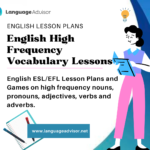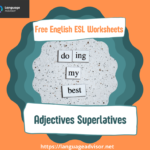Adjectives and Verbs Grammar Lessons. English ESL/EFL Lesson Plans and Games on Adjectives and Verbs Grammar lessons and vocabulary
Adjectives and Verbs Grammar Lessons

Lesson plans
Here you can find a wide range of full lesson plans to use in your classroom.
All of our lessons are designed around themes engaging and relevant to English ESL-EFL learners and can be used to complement your school curriculum, giving students an opportunity to develop their English language and skills in motivating and enjoyable ways.
These lesson plans focus on classroom games and activities oriented around meaningful practice of grammar items in English. The vast majority of the activities have been designed to be simple and easy to apply, without requiring much in the way of additional resources or materials. Wherever possible, games have been presented in a way that makes full use of any natural or genuine communicative aspects embodied in the grammar constructions, though while there is emphasis on understanding the grammar and its functional and communicative aspects, most of the games also highlight the importance of using the grammar accurately.
These lesson plans are intended as a starting point for teachers to adapt and build their own stock of in-class games and activities that can be applied relatively quickly and easily.

Adjectives and Verbs Grammar Lessons
Adjectives and Verbs Grammar Lessons: Here are four lesson plans

Adjective Grammar Lesson and Vocabulary
Objectives:
The students will understand and be able to use adjectives and to add more vocabulary to their English repertoire.
Presentation:
Define for the class what an adjective is: it is a word that describes or modifies a noun or a pronoun. An adjective refers to a noun, a pronoun, or any other word or group of words playing the part of a noun. Adjectives help to describe or limit nouns. They can describe size (tall, big, small), appearance (pretty, ugly, beautiful), personality (kind, intelligent, lazy), color (green, blue, red), and number (one, two, three).
Practice:
– Give students 20 more adjectives:
1. thick =
2. joyful =
3. thin =
4. careful =
5. new =
6. crazy =
7. many =
8. expensive =
9. few =
10. cheap =
11. hardworking =
12. clean =
13. lazy =
14. dirty =
15. intelligent =
16. late =
17. unintelligent =
18. early =
19. angry =
20. beautiful =
– Have the students create their own flashcards to learn these words. Have them draw pictures to represent the meaning of the words.
Homework:
Have the students finish the flashcard activity at home if they have not already finished.


Around the World
Objectives:
The students will understand adjectives and add more vocabulary to their English repertoire.
Warm-Up:
Review the adjectives introduced in the previous lesson by going over the homework.
Presentation:
Define once more for the class what an adjective is: it is a word that describes or modifies a noun or a pronoun. An adjective refers to a noun, a pronoun, or any other word or group of words playing the part of a noun. Adjectives help to describe or limit nouns. They can describe size (tall, big, small), appearance (pretty, ugly, beautiful), personality (kind, intelligent, lazy), color (green, blue, red), and number (one, two, three).
Practice:
– Introduce Color Vocabulary:
1. white =
2. black =
3. blue =
4. red =
5. green =
6. yellow =
7. orange =
8. gray =
9. brown =
10. pink =
– Review all the adjectives that have been taught in the previous lesson.
– Play “Around the World” with the class so that students can practice what they know and then try to memorize the adjectives they have not yet mastered.
Homework:
Have students write 10 sentences (one for each color presented) that uses a pronoun and an adjective correctly.


New Verb Vocabulary
Objectives:
Students should be able to recognize a verb and start to learn the new vocabulary introduced.
Presentation:
Verbs show action and express time (stick to the simple present tense, if your class is a beginner level). A verb can be more than one word. There can be a helping verb and / or a main verb. Again, try not to confuse the lesson by adding too much but maybe give the students a list of the helping verbs just so they know.
Practice:
– List of Helping Verbs:
1. am
2. can
3. had
4. is
5. could
6. shall
7. are
8. would
9. will
10. was
11. has
12. were
13. have
– Introduce list of new Verb vocabulary:
1. run =
2. throw =
3. walk =
4. work =
5. talk =
6. study =
7. sit =
8. read =
9. stand =
10. write =
11. eat =
12. translate =
13. drink =
14. try =
15. start =
16. play =
17. stop =
18. watch =
19. kick =
20. listen =
– Give the class examples so that they understand sentence structure.
For example:
I run.
You run.
She runs.
He runs.
It runs.
We run.
They run.
Note: That the verb is singular in every form but the he / she/ it where
the verb becomes plural.
– More advanced sentences:
I read a book.
You play volleyball.
John watches television.
Sue listens to music.
It drinks water.
We eat cakes.
They study English.
Homework:
Have the students construct 10 sentences using the new verb list and the other vocabulary that they have previously acquired.


Verbs a Grammar Lesson
Objectives:
The students will be able to correctly identify and use verbs.
Warm-Up:
Review the new words from the previous lesson. Also it may take some time, but go around the class and have the students share their sentences that they were to do as homework. This way you can tell if they have grasped the concept and it will help them to learn the new words that were given.
Presentation:
Redefine verbs and their functions.
Practice:
– Have the students copy down the following sentences and be able to identify the verbs in each one by underlining.
1. Mike runs to school everyday.
2. Sometimes I try to speak Russian.
3. I can hardly read this book.
4. My dog sits on the front porch.
5. They play basketball all day long.
6. Why don’t you drink any vodka?
7. The students watch television.
8. I stand in front of the classroom.
9. That woman walks fast.
10. Kick the ball!
– Once the students have completed this task in their own notebooks go through the activity as an entire class making sure that they understood.
– Have the students make a list of 3 verbs they would like to know in English and then playing Charades or drawing the action on the board.
Note: make sure to write down all the new words the students come up with to add those to the list of vocabulary learned.
Homework: Using the new list of verbs that the students selected, have the students create more complex sentences like the ones done in class. They should write 7 to 10 sentences in total as their home task.

Adjectives and Verbs Grammar Lessonss: Also Check out these resources on English Adjectives and Verbs


















